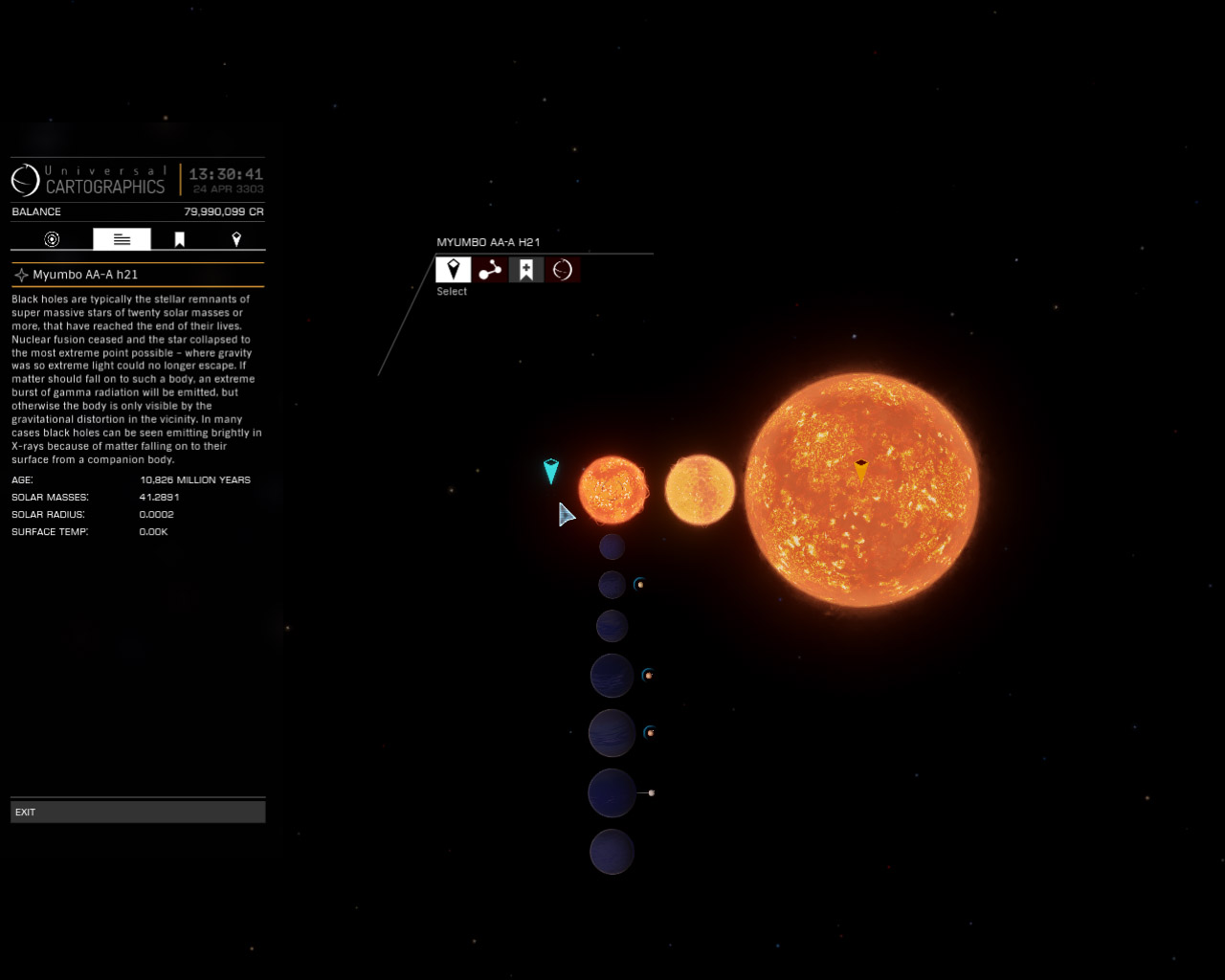You are using an out of date browser. It may not display this or other websites correctly.
You should upgrade or use an alternative browser.
You should upgrade or use an alternative browser.
Post your weird systems!
- Thread starter Surly_Badger
- Start date
This gas giant must be employee of the month or something. For reference, Mercury's perihelion is roughly 200 light seconds.

- - - Updated - - -
I just had to snap a planet-side picture.

UPDATE: I ran into a few more extremely close gas giants, including this bad boy that is only 20 ls from its star:


- - - Updated - - -
I just had to snap a planet-side picture.

UPDATE: I ran into a few more extremely close gas giants, including this bad boy that is only 20 ls from its star:

Last edited:
The comma in British English is a thousand separator, right?
That makes that black hole 15 billion (short scale) years old, older than the 13.8 billion years of the universe!
It's the big bang remnant - oldest thing in the cosmos.
Orbiting a neutron star, only a few Ls away
[video=youtube;ZIt3r55Wc0M]https://www.youtube.com/watch?v=ZIt3r55Wc0M[/video]
A couple of space oddities, starting with a ringed gas giant with water-based life orbited by four ringed gas giants with ammonia-based life:

A system with two large, ringed ammonia worlds:

And two gas giants with terraformable HMC and water world moons:



A system with two large, ringed ammonia worlds:

And two gas giants with terraformable HMC and water world moons:


2nd one from bottom... In a binary with a WW... And a WW as a moon of the Gas giant... what...
Oh and terraformable!
Yeah, unfortunately the binary, ringed WW was not terraformable; must be the tidal forces of the gas giant that keeps the water moon warm.
Posted this in a thread a while back, but my oddest from a 12k ly trip into the deep was this single star system, with 21 true planets.
And iirc, the first 18 are within 2700 ls of primary. Real easy to scan

And iirc, the first 18 are within 2700 ls of primary. Real easy to scan

Last edited:
This 'miracle' red dwarf has a habitable zone encompassing all eight planets in orbit:




That would be due to the neutron star. It's apparently close enough to the red dwarf that its habitable zone covers all eight orbits around the dwarf. A fairly common scenario in multiple-star systems, all the more pronounced when it comes to neutron stars.This 'miracle' red dwarf has a habitable zone encompassing all eight planets in orbit:
(Conveniently ignoring the question whether neutron stars should even have a habitable zone, of course.)
That would be due to the neutron star. It's apparently close enough to the red dwarf that its habitable zone covers all eight orbits around the dwarf. A fairly common scenario in multiple-star systems, all the more pronounced when it comes to neutron stars.
(Conveniently ignoring the question whether neutron stars should even have a habitable zone, of course.)
That is what I assumed, but how Stellar Forge applies this effect always seems a bit off. A neutron star with a surface temp of 4mil K can support an ELW at 4.5k ly, but this neutron star (surface temp of 8mil K) throws off enough radiation to support an ELW over 30l ly away.
(Conveniently ignoring the question whether neutron stars should even have a habitable zone, of course.)
In ED it's all about the quantity of radiation, not the quality of radiation
I call this one 'The Smorgasbord' (Thanks to CMDR Alot for the name!): Red dwarf, red giant, ringed neutron and F class all orbiting a black hole!


 This next one has a few things going for it: largest Class I Gas Giant on record, plus the ringed M- and K-class stars, both with exceptionally large ring systems:
This next one has a few things going for it: largest Class I Gas Giant on record, plus the ringed M- and K-class stars, both with exceptionally large ring systems:




Thanks to the presence of the neutron star as a primary, the rings received quite a bit of illumination, something that is incredibly rare to witness in a black hole system:









Thanks to the presence of the neutron star as a primary, the rings received quite a bit of illumination, something that is incredibly rare to witness in a black hole system:


Last edited:
Earth-Like world (water-based life) and Ammonia World orbiting a Neutron star:
View attachment 120315
That's some find Cmdr.Earth Likes around Neutron stars I've seen but never Ammonia Worlds.
To get both in the same system must be a unique find!

Quite the blue system.
















